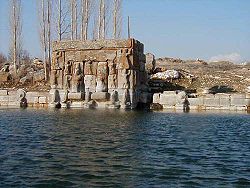
Eflatunpinar
Encyclopedia

Konya
Konya is a city in the Central Anatolia Region of Turkey. The metropolitan area in the entire Konya Province had a population of 1,036,027 as of 2010, making the city seventh most populous in Turkey.-Etymology:...
, and drains into Lake Beyşehir
Lake Beysehir
Lake Beyşehir is a large freshwater lake in Isparta and Konya provinces, southwestern part of Turkey. It is located at around . It has an area of 650.00 km² and is 45 km long and 20 km wide. It carries the same name as the principal urban center of its region, Beyşehir.Water level...
in Anatolia
Anatolia
Anatolia is a geographic and historical term denoting the westernmost protrusion of Asia, comprising the majority of the Republic of Turkey...
n peninsula at ancient Pisidia
Pisidia
Pisidia was a region of ancient Asia Minor located north of Lycia, and bordering Caria, Lydia, Phrygia and Pamphylia. It corresponds roughly to the modern-day province of Antalya in Turkey...
region. In ancient times a small temple was built here to honor one of the ancient Hittite
Hittites
The Hittites were a Bronze Age people of Anatolia.They established a kingdom centered at Hattusa in north-central Anatolia c. the 18th century BC. The Hittite empire reached its height c...
gods, and later Plato
Plato
Plato , was a Classical Greek philosopher, mathematician, student of Socrates, writer of philosophical dialogues, and founder of the Academy in Athens, the first institution of higher learning in the Western world. Along with his mentor, Socrates, and his student, Aristotle, Plato helped to lay the...
was confusely credited with the spring. The shrine precedes Plato
Plato
Plato , was a Classical Greek philosopher, mathematician, student of Socrates, writer of philosophical dialogues, and founder of the Academy in Athens, the first institution of higher learning in the Western world. Along with his mentor, Socrates, and his student, Aristotle, Plato helped to lay the...
of about 1000 years [c.1300 BC]. Eflatun Pinar is the modern name for the location.
The region corresponded to Pisidia
Pisidia
Pisidia was a region of ancient Asia Minor located north of Lycia, and bordering Caria, Lydia, Phrygia and Pamphylia. It corresponds roughly to the modern-day province of Antalya in Turkey...
in Classical Antiquity
Classical antiquity
Classical antiquity is a broad term for a long period of cultural history centered on the Mediterranean Sea, comprising the interlocking civilizations of ancient Greece and ancient Rome, collectively known as the Greco-Roman world...
.
Eflatun Pınar's location near the lake shore corresponds to an almost exact level with other important ruins on the opposite shore, those of Kubadabad Palace
Kubadabad Palace
Kubadabad Palace or Kubad Abad Palace refers to a complex of summer residences built for the sultan and his court during the reign of the sultan of the Sultanate of Rum Kayqubad I...
, which are Seljuk.
Eflatun Pınar was briefly examined by the University of Oxford
University of Oxford
The University of Oxford is a university located in Oxford, United Kingdom. It is the second-oldest surviving university in the world and the oldest in the English-speaking world. Although its exact date of foundation is unclear, there is evidence of teaching as far back as 1096...
archaeologist Dr. Lucia Nixon in her paper on Çatalhöyük
Çatalhöyük
Çatalhöyük was a very large Neolithic and Chalcolithic settlement in southern Anatolia, which existed from approximately 7500 BCE to 5700 BCE...
, and she makes use of F.W.Hasluck's early-20th century work. The site remains largely unexplored to date.
External links
- http://www.swansea.ac.uk/cssee/pdfs/spkrs3.pdf (Pdf file) Anthropology, Archaeology and Heritage in the Balkans and Anatolia
- http://ancient-anatolia.blogspot.com/2008/02/eflatunpinar-hittite-spring-temple-dam.html Views of Eflatunpinar Hittite Spring Temple & Dam.

